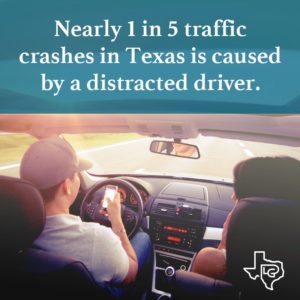According to the Texas Department of Public Safety, as of November 4, 2016, “At least one person has been killed on a Texas road every day for the last 16 years.” Unfortunately, that statistic is only the beginning of the sordid tale. The reality is downright scary.
Texas Motor Vehicle Crash Statistics
Since November 7, 2000, 55,578 Texans have died on our roadways as the direct result of a traffic crash. That is an average of nearly 10 people a day killed on Texas roads. Comparing that with other morbid death statistics:
Pointing out this statistic is, of course, in no way to minimize the importance of any of these deaths, but the numbers speak for themselves. When placed in that context, it is clear that we have a huge problem in Texas that needs to be addressed in one way or another. Addressing it, however, requires a hard look in the mirror at ourselves recognizing that as motorists, we are a huge part of the problem.
Increase in Distracted Driving
I don’t know about you, but it is impossible for me to hear the above information and not immediately flash to the image in my head of someone using their phone while driving, eating a hamburger, typing a text message, or—the worst situation I have ever seen—reading a book on a Kindle placed on the steering wheel (true story). As with any self-help program, we have to recognize that we have a problem and that the things around us, phones, food, radios, and GPS guidance systems have a negative impact on our ability to safely drive.

This phenomenon is, of course, generally referred to as Distracted Driving. Here is how Distracted Driving affects us on Texas roads.
According to statistics from April, 2015, “Nearly 1 in 5 traffic crashes in Texas is caused by a distracted driver.” In that same year, 468 people were killed in a crash attributable to a distracted driver. Using the full-year statistics from 2014, there were 100,825 crashes in Texas involving distracted driving.[5] That number was up 6 percent from the previous year.[6] While I don’t have the current numbers in front of me, I have personally seen an uptick in people doing ridiculous things behind the wheel and I feel confident in saying those numbers have more than likely risen.
How much impact does distracted driving have on us?
According to the Insurance Institute for Highway Safety (IIHS), two separate epidemiological studies linked talking on a cellphone to a fourfold increase in the likelihood of a crash resulting in an injury to the driver and in the risk of a crash involving property damage but no injury. Two other studies found that the risk of a minor crash severe enough to report to police (don’t worry, the PI lawyer in me won’t waste your time arguing that this is not a minor crash) doubled when drivers were talking on a cellphone compared to when they were not visibly distracted [1].
Texting While Driving
When texting the numbers become more alarming. IIHS’s analysis of data from 3,000 drivers who were continuously monitored for up to 3 years during 2010 – 2013 indicated that crash risk was 5 times greater when drivers were manipulating a cellphone compared with when they were not distracted. Another study using the same data, found that texting alone was associated with a 6-fold increase in crash risk relative to when drivers were not distracted or judged to be driving impaired.[2]
I’ll admit freely, that I’m no statistician. I am positive that someone smarter than me will read these studies and possibly find fault in their numbers. But, I’m no dolt either, and it is clear to me that driving distracted greatly increases the likelihood of a crash.
So, what can we do about distracted driving?
Forty-six states and the District of Columbia have banned texting and driving for all drivers. Currently, Texas is one of the only four states with no statewide law banning the use of cellphones while driving.
We are proud to report, however, that this Spring the Texas House passed House Bill 62, a statewide ban on texting while driving. The bill is now in the Senate’s hands. Patterson Law Group will continue to closely monitor this legislation.
House Bill 62 and Senate Bill 31 would allow drivers to text in emergency situations and they do not include using GPS. Violators could be fined up to $99 for a first offense and a maximum of $200 for any offense after that.
Where the State Legislature has previously failed, municipalities have stepped in
While Statewide legislation has failed thus far, 96 municipalities throughout Texas have enacted some form of cell phone ordinance. Those ordinances fall into three categories:
- Ban on all uses of wireless communications devices while driving;
- Ban on texting while driving; and
- Ban on texting and other manual uses of wireless communication devices while driving.
Fines for violating these statutes range from $200 – $500.
Are distracted driving bans the answer?
The short answer, is yes, they can be. According to researchers at the University of Alabama Birmingham School of Public Health, texting bans were significantly associated with a 3 percent reduction in traffic fatalities among all age groups studied. With the sample that they studied, that equated to 19 deaths prevented per year in states with such bans. Laws that banned young drivers from texting were the most effective at reducing deaths among the 15 – 21 year old group, with an associated 11 percent reduction in traffic fatalities among that age group. While any reduction in fatalities is a positive, states with bans prohibiting the use of cellphone without the use of hand held devices on all drivers saw a significant reduction in fatalities among young people and adults above the age of 21.
There is no question that distracted driving greatly increases the likelihood that we are going to hurt ourselves or others. Unless and until we can control ourselves and fight the urge to drive distracted, legislation and stiff fines may be the only thing that can break our dangerous habit.
Other Ways to Reduce Driving Distracted
Distracted driving ranks among the most common causes of preventable accidents. With the rise in smartphone usage over the last several years, a range of products has been introduced to reduce distraction. Many of these products are downloadable smartphone applications, available on either the Apple Store or Google Play Store. While they are helpful and potentially life-saving, a range of other strategies and tools can be used to prevent distractions behind the wheel, including the following:
Utilize “Do Not Disturb” Mode
Both Apple and Android-type smartphones now feature standard “do not disturb” modes that can be toggled while driving. By engaging these options, your phone will silence all notifications until the feature is turned off. In addition, depending on the phone, you may be able to set your “do not disturb” mode to auto-reply to any messages with a user-generated response.
On Apple devices, “do not disturb” mode can be engaged by navigating to the settings menu, selecting “do not disturb,” and tapping “activate.” You will then be able to customize the settings.
For drivers with Android devices, using “do not disturb” mode is even easier. Swipe down from the top of your device’s screen and tap the “do not disturb” button. You can manage your preferences for this feature in the device’s settings menu.
Utilize “Car Mode”
For some drivers, using their smartphones while driving is unavoidable. For instance, many rely on their smartphone’s “maps” feature to navigate while driving or play music in their car using a phone-based music player like Spotify or Apple Music.
Fortunately, these apps have developed “car modes” to help reduce instances of distracted driving. For example, Spotify, Apple Music, and Amazon Music each offer their own iteration of a driving mode, with simplified controls, voice commands, and reduced options.
Similarly, both Google Maps and Apple Maps offer a hands-free, voice-powered navigation mode. With the driving mode enabled, driving directions will be audibly relayed to the driver, reducing drivers’ need to divert their eyes from the road.
Utilize Bluetooth Hands-Free Devices
Most modern smartphones are equipped with Bluetooth connectivity, allowing users to utilize their smartphones hands-free. Many vehicles also offer infotainment systems that connect to the driver’s phone via Bluetooth, allowing them to talk, send text messages, choose music, and receive driving directions without taking their hands or eyes off the road.
These devices reduce distraction by eliminating the need to look at and physically manipulate a mobile device. However, research has found that these hand-free options distract drivers, albeit to a lesser extent, than traditional phone usage.
Don’t Use Your Phone At All
Perhaps the best way to avoid distracted driving is not to use your smartphone. Distracted driving is a leading cause of accidents–even touch-free devices pose a risk. So whether you turn your phone off as you drive, place it in the glove box, or do not bring it at all, you’ll be significantly less likely to be involved in an accident if you avoid using it.
[1] Id. citing Kidd, D.G; McCartt, A.T. 2015. The relevance of crash type and severity when estimating crash risk using the SHRP2 naturalistic driving data. 4th International Driver Distraction and Inattention Conference. ARRB Group Ltd: Sydney, New South Wales.
[2]Id. citing Dingus, T.A., Guo, F., Lee, S., et al. 2016. Driver crash risk factors and prevalence evaluation using naturalistic driving data. PNAS, early edition DOI: 10.1073/pnas.1513271113.










